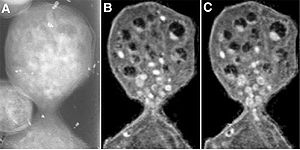
The delicate machinery within life can be bent to the will of experimenters
Scientists have succeeded in forming a “feedback loop” between a computer and a common yeast to precisely control the switching on and off of specific genes.
The computer controlled flashes of light to start and stop this gene expression, “learning” how to reach and maintain a set value.
The groundbreaking approach could find use in future efforts to control biological processes, such as the production of biofuel from microbes.
It appears in Nature Biotechnology.
The approach is a comparatively simple means to take control of fantastically complex biochemical processes to achieve a desired result.
“The neat thing about this is that there are many people who have tried to do things like this by, for example, coding in the cell itself a synthetic circuit, putting genes and mechanisms in the cell,” said senior author John Lygeros, of the Automatic Control Laboratory at the Swiss Federal Institute of Technology Zurich.
“That’s had limited success up to now.”
Prof Lygeros and his colleagues started with the yeast Saccharomyces cerevisiae – a well-studied strain of yeast familiar since ancient times in brewing and baking.
A study in the same journal in 2002 found that when S. cerevisiae is exposed to light, a molecule called phytochrome within it can switch forms; red light converts it to an “active form” and a deeper red converts it back.
The activity of the phytochrome can start or stop the genetic machinery that results in the production of a given protein.
The team used this trick to ensure that when the yeast was producing that protein – corresponding to the gene being switched on – it could be tracked by using a “reporter” molecule that itself gives off light in a process called fluorescence.
In that way, the team had a full loop of control: upon shining red light in, they could track how much a population of yeast cells was expressing the gene, and apply the deeper red to curb that gene expression.
Better behaviour
The process is not simply an on-off switch, Prof Lygeros explained.
“Experimentally, it s a fairly challenging thing to do,” he told BBC News.
“The fluorescence is not the only thing – there are half a dozen chemical reactions involved in this process.”
The team developed a computer model to track how long each burst of light should take to precisely maintain a given amount of gene expression, allowing it to control the light tightly in a feedback loop.
The work adds to a growing amount of scientific literature in which the delicate machinery within life can be bent to the will of experimenters.
Read more . . .
Bookmark this page for “cyborg genes” and check back regularly as these articles update on a very frequent basis. The view is set to “news”. Try clicking on “video” and “2” for more articles.







